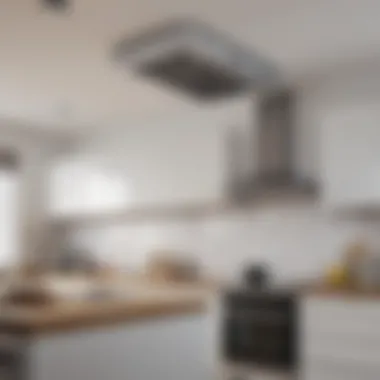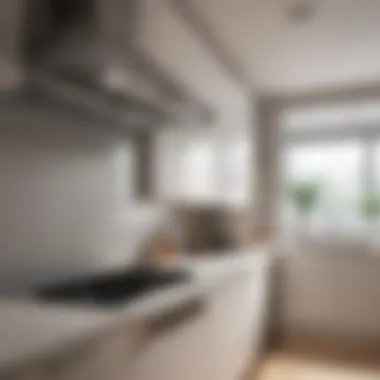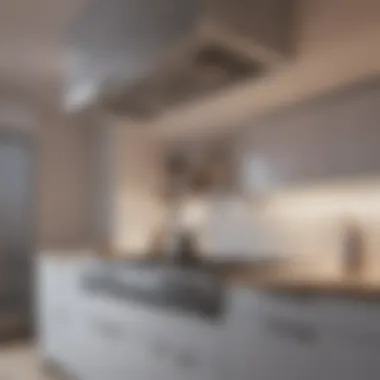Overhead Range Vents: Design and Trends for Kitchens


Intro
In modern kitchen design, overhead range vents hold a critical role, acting as both a functional necessity and a design feature. The ability to keep a kitchen airy while protecting surfaces from grease and smoke is paramount for households that take culinary endeavors seriously. Beyond merely drawing smoke from frying pans, these units have evolved with an array of options and styles. For homeowners and designers alike, it’s vital to grasp the nuances of what makes an overhead range vent effective, attractive, and in tune with the latest trends.
There is a world of choices out there; from sleek stainless-steel designs that evoke a contemporary flair to classic wooden models that match traditional aesthetics. It's not just about choosing a vent; it's about enhancing the kitchen's overall vibe while ensuring that the space remains functional.
Let’s take a closer look at the various styles available and how you can incorporate them effectively into your kitchen, maintaining both elegance and practicality.
Understanding Overhead Range Vents
The significance of overhead range vents cannot be overstated, especially in the context of modern kitchens where cooking styles and trends are evolving. These systems are integral to maintaining not just comfort but also health and aesthetics in kitchen spaces. By understanding their definition, purpose, and historical development, designers and homeowners can make informed choices when it comes to purchasing and installing these essential appliances.
Definition and Purpose
Overhead range vents are basically appliances designed to remove smoke, steam, odors, and grease from the air while cooking. Often positioned directly above a cooktop or range, they function by sucking up the air from the cooking area and venting it outside or filtering it for recirculation. The key purposes of these vents include:
- Air Quality Improvement: Enhancing the air quality by reducing indoor air pollution.
- Grease Control: Preventing the accumulation of grease on kitchen surfaces, which can become a health hazard.
- Comfort: Creating a more pleasant environment by eliminating cooking smells and humidity.
- Aesthetic Enhancement: Adding value and style to the kitchen’s overall design, making it a functional yet chic space.
A well-designed overhead range vent not only serves practical functions but also contributes to the kitchen's visual appeal. With the right model, homeowners can ensure that both aesthetics and functionality coexist seamlessly.
History of Ventilation Systems in Kitchens
To fully appreciate the advancements in overhead range vents, it is essential to look back at the history of kitchen ventilation systems. Early kitchens did not have any dedicated ventilation systems, which meant cooking was a smoke-filled endeavor. Traditional fireplaces were common, and the smoke was unleashed into the home, leading to considerable discomfort.
In the mid-20th century, the introduction of range hoods marked a turning point. Initially, these were simple exhaust systems, often noisy and inefficient. However, as technology progressed, the designs became more refined, leading to effective air filtration and quieter operations.
Today, we have a broad spectrum of options varying in design, power, and efficiency. Modern overhead range vents are not merely functional tools; they are high-tech devices that often come equipped with a variety of features like smart sensors, LED lighting, and customizable appearances.
"Understanding the evolution of kitchen ventilation gives insight into how crucial these components are to contemporary kitchens. Without them, we would be flirting with discomfort—especially while flipping those pancakes!"
In summary, recognizing the role of overhead range vents, alongside the rich history that shapes them, is crucial for anyone looking to invest in their kitchen's functionality and ambiance.
Technical Aspects of Overhead Range Vents
The technical aspects of overhead range vents play a pivotal role in ensuring an efficient and effective ventilation system within modern kitchens. Understanding how these systems function not only aids in selecting the right vent but also highlights their importance in maintaining air quality and safety in cooking spaces. There’s more to these overhead fixtures than meets the eye; they are engineered with specific functionalities that resonate with the needs of contemporary culinary environments.
How Overhead Range Vents Work
Overhead range vents primarily work by drawing in smoke, odors, heat, and moisture that emit during cooking processes. They utilize various mechanisms, such as fans and filters, to enhance air circulation and eliminate unwanted particles from the kitchen environment. When a cooking activity is triggered, sensors within the vent may activate the fan, pulling air through a network of ducts.
These systems often come equipped with multiple airflow settings, allowing users to adjust power according to the intensity of cooking. This flexibility makes them both versatile and energy-efficient. Moreover, some overhead range vents use heat sensors, which optimize their performance based on the temperature of surrounding air, thus preventing excessive energy consumption.
Types of Overhead Range Vents
The market offers a variety of overhead range vents, each suited to specific kitchen layouts and cooking styles. Understanding the options can help both designers and homeowners make informed choices.
Downdraft Vents
Downdraft vents are notable for their ability to retract into the countertop when not in use, making them an excellent choice for kitchens with limited overhead space. Their low profile is particularly advantageous in kitchens where aesthetics are a priority. Unlike traditional vent hoods, these models draw air downward, preventing smoke and odors from spreading throughout the kitchen.


The key characteristic of downdraft vents is their integrated design, allowing for a seamless look that blends with contemporary kitchen designs. Their unique feature—retractable elements—offers considerable space savings. However, one drawback is that they might not be as powerful as their wall-mounted counterparts when it comes to handling heavy cooking fumes.
Wall-Mounted Vents
Wall-mounted vents serve as the traditional option in many kitchens, installed directly to the wall above the cooking area. Their design typically features a larger blower and fan size, which translates to higher airflow rates, making them an efficient solution for handling intense cooking scenarios.
The standout benefit of wall-mounted vents is their capability to handle a greater volume of smoke and odors due to the elevation above cooking surfaces. Another appealing aspect is the varied design options available, which allows homeowners to match their kitchen's aesthetics. However, one potential downside could be the space they occupy, which might not suit smaller kitchen layouts well.
Island Vents
Island vents are designed specifically for kitchens with island cooking ranges. These models are suspended from the ceiling over the island, offering both functionality and style. Their presence can serve as a focal point in open-concept kitchens, enhancing the overall vibe of the space.
A key characteristic of island vents is their circular or rectangular design options, providing multiple choices for visual appeal. They excel in optimizing airflow, as they are centrally located, drawing in contaminants from all sides. However, they can sometimes require complex installation procedures and adjustments to existing ceiling frameworks, making professional installation a consideration to keep in mind.
Design Considerations
When diving into the world of overhead range vents, design considerations play a crucial role in both functionality and aesthetics. These elements determine not just how well the vent performs but also how well it harmonizes with the overall look of the kitchen space. Many homeowners and designers alike tend to overlook the importance of these aspects, but a well-integrated range vent can truly transform a kitchen from ordinary to extraordinary.
Aesthetic Integration into Kitchen Design
Aesthetic integration goes beyond merely selecting a vent that matches the color scheme. It’s about creating a cohesive design narrative throughout the kitchen. Overhead range vents can be statement pieces, drawing the eye and setting the tone of the space. Modern kitchens lean heavily towards open concepts that require careful consideration of every visible element. This is especially true for range vents, which can often sit prominently above the cooking area.
To achieve seamless integration, it’s vital to think about not just the color but also the shape and width of the vent. A sleek, linear vent can complement minimalist or contemporary designs, while a more ornate style can enhance traditional kitchens. Designers should also consider the height at which the vent will be mounted; if it's too high or too low, it can disrupt the visual flow of the room.
Material Choices for Overhead Range Vents
The materials used in creating these vents can enhance not only the design but also their efficiency and durability. Different materials carry unique characteristics that should be closely evaluated.
Stainless Steel
Stainless steel often stands out as a top choice for range vents, thanks to its remarkable durability and resistance to corrosion. Its shiny surface catches light, providing a sleek look that works well with various kitchen themes—whether contemporary or traditional.
One notable feature of stainless steel is its easy maintenance; it can be cleaned with simple household products, which is a boon for busy homeowners. However, it’s worth mentioning that this material can show fingerprints and smudges, so regular cleaning is necessary to keep it looking new. Nonetheless, its longevity and overall appearance make stainless steel a popular option.
Composite Materials
Composite materials bring a different flavor to the table, often combining various substances to achieve a functional yet stylistic choice. These can include recycled materials, which align with sustainable practices, something that's gaining traction in today’s eco-conscious market.
One key characteristic of composites is their versatility in design. They can be molded into various shapes and finishes, offering broader design possibilities. They may not have the same durability as stainless steel, particularly when exposed to heat over long periods, but their lightweight nature and cost-effectiveness make them appealing for many homeowners.
Glass and Other Finishes
Lastly, glass and other unique finishes can add a touch of elegance that many modern kitchens strive for. Glass range vents can introduce transparency that helps lighten the ambiance and can be particularly striking in spacious areas.
The shiny surface of glass can also reflect light, creating an airy feel. However, it does come with its set of challenges—namely, it can be more fragile compared to metal options and may require more frequent cleaning to maintain its luster.
In summary, selecting the right materials for overhead range vents involves weighing the aesthetic values against functionality. Each material offers its own set of benefits and drawbacks, making it crucial for designers and homeowners to align choices with both personal preferences and practical needs.
Functionality and Efficiency
When we think about overhead range vents, it might be easy to focus solely on the visual appeal or how well they integrate into a kitchen's design. However, the core of these devices lies in their functionality and efficiency. This section unpacks why prioritizing operational prowess when selecting a range vent can profoundly affect the comfort and usability of a kitchen space.


Assessing Ventilation Needs in Kitchen Spaces
Every kitchen tells a story, with cooking habits and styles shaping its atmosphere. Each chef or home cook has unique habits—some whip up light meals, while others see the kitchen as their experimental lab, often firing up multiple pans at once. The ventilation needs will vary significantly based on these factors, making it crucial to assess the specific requirements of any given space.
Begin by evaluating the size of the kitchen. A compact kitchen with limited cooking is less demanding than an expansive space where culinary creativity runs wild. Consider:
- Cooking Appliances: The type and number of cooking tools can dictate how much ventilation support is needed. Do you have a powerful gas range, or is it an electric flat-top?
- Frequency of Use: The more often a kitchen is used for heavy cooking, the more robust the ventilation system should be. If you routinely cook meals that generate grease and smoke, don’t skimp on the vent's strength.
- Open Concept Layouts: An open concept must accommodate airflow throughout multiple areas. This can help maintain air quality in attached living spaces while ensuring adequate ventilation.
The Role of CFM Ratings
When discussing the efficiency of range vents, the term CFM or Cubic Feet per Minute becomes paramount. This metric indicates the volume of air that a vent can move. In the world of kitchen ventilation, understanding CFM ratings is akin to knowing the horsepower of a car. It’s what gives you an idea of how powerful a vent is and whether it’s up to your cooking needs.
- Choosing the Right CFM: For light cooking, a CFM rate of 200-300 may suffice, but for serious culinary enthusiasts, anything below 600 might not cut it. The general rule is that for every 12 inches of cooking surface width, aim for about 100 CFM.
- Balance Is Key: However, it’s not just raw power that matters. Too much CFM can lead to excessive noise and might draw too much air from the kitchen, creating discomfort. It’s all about finding the sweet spot that matches the kitchen's size, layout, and cooking habits.
"An overhead range vent should not only look good, but it must also behave dependably, ensuring that steam, aromas, and smoke have no battlefield to linger in."
In summary, understanding functionality and efficiency diving into overhead range vents merges the practical with the aesthetic. By evaluating your needs and selecting a vent with appropriate CFM ratings, one can enhance both the cooking experience and the overall kitchen environment.
Installation Practices
Installing overhead range vents is not just a trivial task but a significant part of achieving optimal kitchen functionality and aesthetics. Proper installation practices ensure that the ventilation system performs efficiently, enhancing indoor air quality and keeping the cooking environment pleasant. Without the right approach, homeowners could face issues that not only compromise the efficiency of the vent but also create safety concerns in the kitchen. A poorly installed vent can lead to less effective smoke and odor removal, increasing the likelihood of grease buildup—something no one wants in their cooking space.
Planning for Installation: Key Factors
When it comes to planning the installation of an overhead range vent, several critical elements must be considered to ensure that it meets both functional and aesthetic goals.
- Kitchen Layout: Identify where the stove is positioned and how the vent will integrate into the existing space. Factors such as proximity to windows and doors, as well as the layout of the kitchen counters, can significantly influence the installation's success.
- Vent Type: Choose the right type of ventilator based on placement options. For instance, if you have a kitchen island, an island vent is essential, whereas a wall-mounted option suits a conventional kitchen setup.
- Ductwork: The duct size and configuration are paramount to achieving proper airflow. Ensure that the duct shape doesn’t create unnecessary bends or turns, as this can reduce efficiency. The path from the range to the outside should be as straight as possible to optimize performance.
- Electrical Requirements: Depending on the model, an overhead range vent may require electrical connections. It’s vital to ensure the circuit can handle the demands of the appliance without safety hazards.
- Height Adjustments: Consider the cooking height in your kitchen. The vent should be installed at a height that captures rising smoke and odors but does not obstruct cooking tasks. A general guideline is placing the hood 24 to 36 inches above the cooking surface, but individual kitchen needs may vary.
- Local Building Codes: Be aware of any local regulations or building codes that apply to vent installations. These may dictate some aspects of the setup, impacting not just effectiveness but safety as well.
By considering these factors, one can plan effectively for an overhead range vent installation that meets both design aspirations and functional requirements.
Professional Installation vs. DIY
Whether to tackle the installation of an overhead range vent oneself or hire a professional is another point of consideration. Each option has its merits, and the choice often depends on several variables, including expertise, budget, and time availability.
- Professional Installation: Opting for professional installation means that the task is handled by someone with experience in vent installations. This can lead to:
- DIY Installation: On the other hand, some might choose DIY for reasons like cost-saving or personal satisfaction. While it can be fulfilling, it’s essential to approach with caution:
- Guaranteed Safety: Professionals understand the intricate safety standards that must be followed.
- Efficiency: They can quickly identify the right placement and ensure optimal performance.
- Warranty Coverage: Many manufacturers may require professional installation for warranty claims to be valid. Having a reputable contractor handle the setup can provide peace of mind.
- Cost Saving: You could potentially save a few bucks, provided you already have the tools.
- Skill Building: For those eager to learn, this can be a valuable opportunity to enhance home improvement skills.
- Time Investment: Remember that this approach might take longer if you’re not experienced, which could lead to missteps and frustrations.
Ultimately, the choice between professional installation and DIY boils down to individual comfort levels with home repairs, the complexity of the vent system, and specific budget constraints. Being informed allows for a well-thought-out decision, contributing to a hassle-free kitchen ventilation experience.
Maintenance and Care
Proper maintenance and care of overhead range vents is crucial for ensuring their optimal performance and longevity. When it comes to kitchen ventilation systems, neglect can lead to various issues that not only affect the functionality of the vents but also the overall air quality in the cooking space. These systems work hard to remove steam, smoke, and cooking odors, which means they must be kept in top-notch condition.
Efficiency and Safety Considerations
Routine care is not just about keeping things clean; it also address key safety concerns. A malfunctioning vent can cause smoke to build up, reducing visibility during cooking, which can lead to accidents. This point is particularly pertinent in households where preparing food is a daily task. Keeping the vent filters clean, inspecting for blockages, and regularly checking the operational functions can prevent hazardous situations.
Furthermore, maintaining these systems helps improve their energy efficiency. Clogged filters and ducts can force the vent motors to work harder, thus increasing energy costs. Homeowners looking to save a penny or two will find that a bit of diligence in care and maintenance goes a long way.


Routine Maintenance Tasks
To keep your overhead range vent in optimal shape, consider incorporating the following tasks into your cleaning routine:
- Clean Filters Regularly: Filters should be removed and cleaned at least once a month. Depending on the frequency of cooking, you may need to do this more often. A dirty filter not only restricts airflow but also hampers the suction power of the vent.
- Check the Fan: Verify that the fan is operating smoothly. If it is noisy or wobbling, it could indicate a problem that needs urgent attention.
- Inspect Ductwork: Ensure that ducts are free from lint or grease build-up. This can be done through a little visual inspection and, if necessary, a deeper clean that might require professional help.
- Look for Wear and Tear: Regularly check all components for any signs of wear. This could include rust, cracks, or loose fittings that may need replacement.
Regular attention to these maintenance tasks can save you from costly repairs or replacements down the line.
Troubleshooting Common Issues
Even with routine maintenance, sometimes things can go awry. Here are a few common issues you might encounter and some initial steps for troubleshooting them:
- Poor Airflow: If the vent seems to be struggling to pull air, check for blockages in the ducts or a dirty filter. Replacing or cleaning these parts can often rectify the issue.
- Unpleasant Odors: If cooking smells persist even after using the vent, there might be a problem with the internal grease traps or ductwork. Inspect them for build-up.
- Increased Noise: Unusual sounds usually indicate a malfunctioning fan. This can be an indication that it requires lubrication or may need parts replaced.
- Light Indicators: If your vent has indicator lights, ensure they signify normal functioning. If a warning light appears, consult the vent’s manual for specific codes.
A proactive approach to troubleshooting can help maintain the sanity of your cooking environment and the efficacy of the vent, ensuring a pleasant culinary experience.
"Regular maintenance isn’t just a chore; it’s the key to keeping your kitchen air clean and safe."
By focusing on these maintenance and care aspects, designers, homeowners, and DIY enthusiasts will find that overhead range vents can function longer and more efficiently, providing the fresh air conducive for any kitchen.
Current Trends in Overhead Range Vent Designs
The ongoing evolution of kitchen design has propelled overhead range vents into the spotlight. These elements are no longer mere utilities; they embody a blend of functionality and style that speaks volumes about a home’s aesthetic. As kitchens transform into multifaceted spaces for both cooking and socializing, the trends in overhead range vent designs reflect this shift, focusing on user experience, design elegance, and technological advancements.
Minimalistic and Sleek Aesthetics
Minimalism in design is about stripping things down to their essence, prioritizing functionality while keeping the visual impact striking yet understated. In the kitchen, overhead range vents are embracing this ethos significantly. Vents are designed now with clean lines, blending seamlessly into cabinetry and ceilings.
- Integrated Designs: No longer do range vents assert themselves as bulky appliances. Products like the Zephyr Napoli or the Vent-A-Hood model incorporate linear styles and low profiles, making them less eye-catching but highly effective.
- Color Options: Manufacturers are now offering a variety of colors and finishes. Stainless steel is common, but matte black and white options appeal to a wider range of design preferences. These finishes enable homeowners to match the vent with their overall kitchen color scheme, resulting in an effortless cohesiveness.
- Lighting Integration: Some designs go beyond functionality, incorporating LED lighting to enhance the cooking area, while also serving a dual purpose of ambient lighting during social events. An example is the Faber eVento Series, which brilliantly combines both direct and ambient light features into range hoods.
Adopting a minimalistic approach contributes not only to the beauty of the kitchen but also to its practicality. A clean aesthetic aids in visual unclutteredness, allowing other design elements to shine while still prioritizing efficient ventilation.
Smart Ventilation Solutions
As smart technology continues to permeate our lives, overhead range vents are increasingly adopting intelligent features that facilitate an enhanced cooking experience. These smart ventilation solutions offer convenience, energy efficiency, and improved air quality, addressing the modern homeowner's need for advanced yet practical appliances.
- Sensor Technology: Smart vents often come equipped with sensors that detect heat and humidity levels, automatically adjusting fan speeds based on cooking requirements. Products like the Broan NuTone Smart Vent utilize sensors to optimize airflow while minimizing noise, ensuring that ventilation adapts to cooking activities in real-time.
- Mobile Connectivity: Many modern vents now integrate app connectivity, allowing homeowners to control settings remotely via smartphones. This feature means users can turn the vent on or off or schedule operations while multitasking in other areas of the home. Brands like KitchenAid have introduced models that seamlessly sync with smart home systems, showcasing a commitment to user-centric design.
- Energy Efficiency: With a rise in awareness concerning environmental impact, vents that maximize energy efficiency are becoming essential. Advanced motor technology allows for less electricity usage while still maintaining high performance levels. Technologies like those seen in the Samsung range are an example of energy-efficient solutions combined with smart venting.
Finale
The topic of overhead range vents, while often overlooked, holds significant weight in creating both a functional and aesthetically pleasing kitchen environment. The importance of properly designed ventilation extends beyond mere appliance placement or design—it greatly influences air quality, comfort, and even the durability of kitchen materials and furnishings. By engaging with the various facets of overhead range vents, homeowners, designers, and DIY enthusiasts can deepen their understanding of how these systems interact with the kitchen’s overall ecosystem.
Summary of Key Insights
A fundamental takeaway from exploring overhead range vents is recognizing their critical role in maintaining kitchen hygiene and safety. Functional designs allow for effective removal of smoke, grease, and odors, ensuring that the cooking space remains pleasant and healthy. Moreover, the evolution of vent designs to more minimalistic styles reflects contemporary tastes, bridging utility and aesthetic appeal. Additionally, advancements in smart technology are reshaping how these systems operate—enabling adaptability to cooking habits and enhancing efficiency.
- Effective ventilation protects health by removing hazardous particulates.
- Aesthetically pleasing vents can harmonize with contemporary kitchen designs.
- Smart technology offers modernization, adding convenience.
"The air we breathe in our kitchens profoundly affects our overall well-being; investing in a good range vent should be seen as an essential element of kitchen design," a sentiment echoed by many experts in home improvement.
Future of Overhead Range Vents in Kitchen Design
The future of overhead range vents seems promising, with emerging trends that could redefine the culinary space. As homeowners increasingly prioritize energy efficiency and air quality, the market is likely to see a shift towards more integrated, smart ventilation systems that feature automatic adjustments based on cooking activities.
Moreover, as sustainable design gains traction, the use of eco-friendly materials and energy-efficient technologies will likely become the norm. Expect to see an increased incorporation of technical advancements that allow for silent operation, improved air filtration systems, and seamless integration within cabinetry.
The trends not only spotlight design aesthetics but also push for functionality that complements busy lifestyles. The next wave of kitchen innovation will undoubtedly include overhead range vents that respond intuitively to their environment, offering not just a practical solution to kitchen air quality but also a testament to modern lifestyles that value both form and function.















